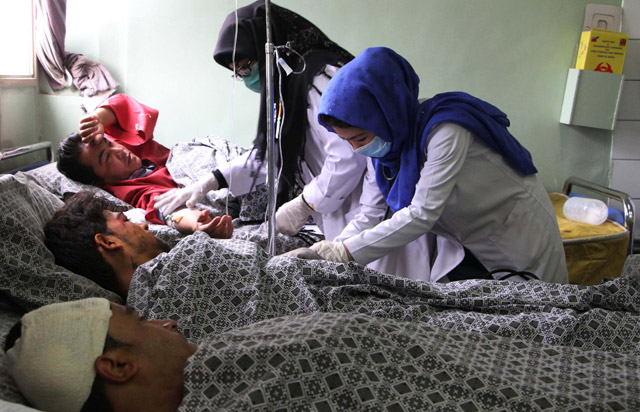KABUL — A powerful blast targeting an armoured NATO convoy in Kabul killed at least eight people and wounded 28 on Wednesday, including three coalition troops, officials said in an attack claimed by the Daesh terror group.
The explosion, which came during morning rush hour on a busy road near the US embassy and NATO headquarters, killed “mostly” civilians, an interior ministry spokesman told AFP without giving a breakdown.
Three coalition service members received “non-life threatening wounds” but are in stable condition, a spokesman for US Forces-Afghanistan said, without confirming their nationalities.
The attack, claimed by Daesh via its Amaq propaganda agency, comes three weeks after the US dropped its largest non-nuclear bomb on the jihadist group’s hideouts in eastern Afghanistan, triggering global shockwaves.
Monday’s blast also comes days after the Taliban launched their “spring offensive”, heralding a surge in fighting as the US seeks to craft a new Afghan strategy and NATO mulls boosting troop levels to break the “stalemate” against the resurgent militants.
The attack, which Daesh said was a suicide car bomb and NATO said was an improvised explosive device, damaged two of the convoy’s heavily armoured vehicles and left a small crater in the road.
MRAP (Mine Resistant Ambush Protected) vehicles, which are designed to withstand large explosions, are routinely used by international forces moving around Kabul.
At least three civilian cars were also damaged, with one ablaze, while windows were shattered up to several hundred metres away. Firefighters and ambulances rushed stunned survivors to hospital as President Ashraf Ghani slammed the blast as a “criminal act”.
NATO commander in Afghanistan General John Nicholson has said the US decision to drop the GBU-43/B Massive Ordnance Air Blast in Nangarhar province last month was a “very clear message” to Daesh: “If they come to Afghanistan they will be destroyed.”
Some observers have condemned the move against a group that is not considered as big a threat to Afghanistan as the Taliban. Others suggested it would boost the Taliban, who have been in a turf war with Daesh in Nangarhar.
The weapon, dubbed the “Mother of All Bombs”, killed at least 95 extremists, according to the Afghan defence ministry, but fighting in the area has continued.
Last week, two US troops were killed in an operation against Daesh near where the bomb was dropped. The Pentagon has said it is investigating if they were killed by friendly fire.
Grinding conflict
Pentagon chief Jim Mattis warned of “another tough year” for both foreign troops and local forces in Afghanistan when he visited Kabul last month, though he would not be drawn on calls by Nicholson for a “few thousand” more troops against the Taliban insurgents.
But NATO chief Jens Stoltenberg told a German newspaper Sunday that the 28-nation alliance was considering boosting its troop strength once more given the “challenging” security situation.
The US has around 8,400 troops in the country with about another 5,000 from NATO allies. Most are taking part in NATO’s train, assist and advise mission, though some are also carrying out counter-terror missions targeting Daesh and Al Qaeda.
First emerging in 2015, Daesh’s local affiliate in Afghanistan overran large parts of Nangarhar and Kunar provinces, near the Pakistan border, but their part in the Afghan conflict had been largely overshadowed by the operations against the Taliban.
Captain Bill Salvin, spokesman for US Forces-Afghanistan, said the local Daesh presence peaked at between 2,500 to 3,000 but that defections and recent battlefield losses had reduced their number to a maximum of 800.
“We have a very good chance of destroying them in 2017,” Salvin told AFP recently.
Embattled Afghan forces meanwhile have been straining to beat back the Taliban insurgents since US-led NATO troops ended their combat mission in December 2014.
A report by US watchdog SIGAR said they suffered “shockingly high” casualties in the first three months of 2017.
Afghan analyst Ahmad Muradi told AFP on Wednesday that whether attacks are carried out by Daesh or the Taliban, “the result is the same: it makes the government and its international supporters tired, and security forces too stretched out, fighting several enemies on several fronts at the same time”.
With more than one third of Afghanistan outside of government control, civilians continue to bear the heaviest brunt of the fighting, with thousands killed and wounded each year and children paying an increasingly disproportionate price, according to UN figures.
